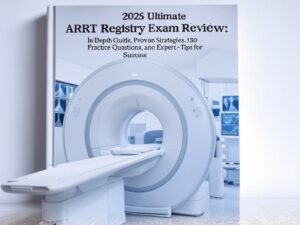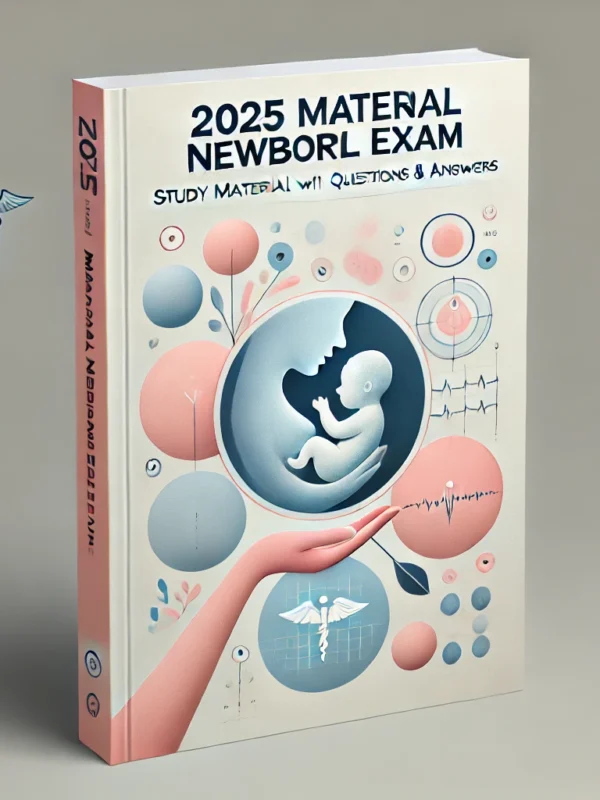The 2025 Ultimate ARRT Registry Exam Review: In-Depth Guide, Proven Strategies, 150 Practice Questions, and Expert Tips for Success is a comprehensive study tool tailored for radiologic technologists preparing for the 2025 ARRT (American Registry of Radiologic Technologists) Registry Exam. This in-depth guide covers all five major content areas of the exam—Patient Care, Safety, Image Production, Procedures, and Radiation Protection—aligned with the latest ARRT content specifications. It includes 150 practice questions in formats mirroring the actual exam, such as multiple-choice and scenario-based questions, covering topics like minimizing radiation exposure using ALARA principles, positioning for a PA chest X-ray, and managing contrast media reactions. Each question comes with detailed explanations, for instance, explaining why a grid is used to reduce scatter radiation in a specific imaging scenario or how to calculate the correct mAs for optimal image quality. The guide also provides proven strategies for exam success, including time management techniques, methods to interpret complex questions, and tips for maintaining composure during the computer-adaptive test (CAT) format. With expert insights on key concepts like the inverse square law, patient positioning for advanced modalities (e.g., CT and MRI), and ethical considerations in patient care, this resource ensures candidates are thoroughly prepared to pass the ARRT Registry Exam and excel in their radiologic technology careers.
Preview
1. What is the correct term used to describe an intravenous injection of a
concentrated volume of contrast media?
a. Bolus
b. Infusion
c. Extravasation
d. Luminal
✅ Correct Answer: a. Bolus
Rationale: A bolus injection refers to a rapid administration of a concentrated dose of
contrast media directly into the bloodstream to enhance vascular structures or organ
perfusion. It is commonly used in CT and MRI for time-sensitive imaging.
2. Which of the following methods utilizes a detector that captures x-ray energy and
converts it into an electronic signal?
a. Indirect capture
b. CCD
c. Cassette-based radiography
d. Direct capture
✅ Correct Answer: d. Direct capture
Rationale: Direct capture radiography systems use a photoconductor (such as
amorphous selenium) that directly converts x-ray photons into an electronic signal
without intermediate steps, resulting in higher spatial resolution and efficiency.
3. The energy of a characteristic x-ray photon created when an L shell electron fills
a K shell vacancy in a tungsten atom will have which of the following energies?
a. 69.5 keV
b. 57.5 keV
c. 91.5 keV
d. 12 keV
✅ Correct Answer: b. 57.5 keV
Rationale: The energy of a characteristic x-ray photon is calculated by subtracting the
binding energy of the L shell (12 keV) from the K shell (69.5 keV), yielding 57.5 keV.
4. Identify the position that will place the positive contrast agent in the body of the
stomach and pylorus during a double contrast upper GI exam:
a. Recumbent LPO
b. Supine
c. Recumbent RPO
d. Prone
✅ Correct Answer: d. Prone
Rationale: The prone position allows gravity to move the contrast into the body and
pyloric region of the stomach, providing optimal visualization during a double contrast
upper GI study.
concentrated volume of contrast media?
a. Bolus
b. Infusion
c. Extravasation
d. Luminal
✅ Correct Answer: a. Bolus
Rationale: A bolus injection refers to a rapid administration of a concentrated dose of
contrast media directly into the bloodstream to enhance vascular structures or organ
perfusion. It is commonly used in CT and MRI for time-sensitive imaging.
2. Which of the following methods utilizes a detector that captures x-ray energy and
converts it into an electronic signal?
a. Indirect capture
b. CCD
c. Cassette-based radiography
d. Direct capture
✅ Correct Answer: d. Direct capture
Rationale: Direct capture radiography systems use a photoconductor (such as
amorphous selenium) that directly converts x-ray photons into an electronic signal
without intermediate steps, resulting in higher spatial resolution and efficiency.
3. The energy of a characteristic x-ray photon created when an L shell electron fills
a K shell vacancy in a tungsten atom will have which of the following energies?
a. 69.5 keV
b. 57.5 keV
c. 91.5 keV
d. 12 keV
✅ Correct Answer: b. 57.5 keV
Rationale: The energy of a characteristic x-ray photon is calculated by subtracting the
binding energy of the L shell (12 keV) from the K shell (69.5 keV), yielding 57.5 keV.
4. Identify the position that will place the positive contrast agent in the body of the
stomach and pylorus during a double contrast upper GI exam:
a. Recumbent LPO
b. Supine
c. Recumbent RPO
d. Prone
✅ Correct Answer: d. Prone
Rationale: The prone position allows gravity to move the contrast into the body and
pyloric region of the stomach, providing optimal visualization during a double contrast
upper GI study.








Reviews
There are no reviews yet.